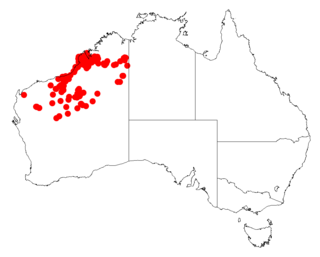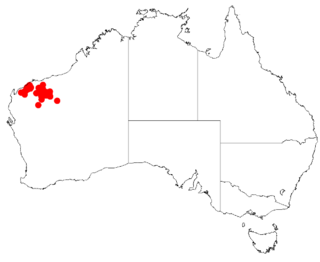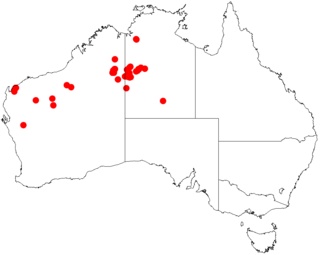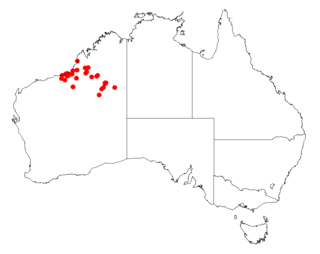
Acacia xiphophylla, commonly known as snakewood or snake-wood, is a tree in the family Fabaceae that is endemic to Western Australia. The indigenous group the Martuthunira, Ngarluma and Yindjibarndi peoples know it as marrawa, the Kariyarra know it as puluru and the Jiwarli know it as pukarti.

Acacia tetragonophylla, commonly known as curara, kurara or dead finish, is a tree in the family Fabaceae that is endemic to arid and semi-arid parts of central and western Australia.

Acacia murrayana is a tree in the family Fabaceae. It has numerous common names, including sandplain wattle, Murray's wattle, fire wattle, colony wattle and powder bark wattle that is endemic to arid areas in every mainland State except Victoria.

Acacia eriopoda, commonly known as the Broome pindan wattle and the narrow-leaf pindan wattle, is a species of wattle in the legume family that is native to northern Western Australia. It is also known as Yirrakulu to the Nyangumarta people.

Acacia spondylophylla, commonly known as curry wattle or spine-leaf wattle, is a small, flat topped shrub native to central and western Australia. The leaves, which are arranged on spaced whorls around the stem, have a distinctive curry-like smell.

Acacia atkinsiana, commonly known as Atkin's wattle, is a shrub belonging to the genus Acacia and the subgenus Juliflorae endemic to Australia. The indigenous peoples of the area where the shrub is found, the Kurrama peoples, know the shrub as Bilari or Pilarri.

Acacia bromilowiana, commonly known as Bromilow's wattle, is a tree belonging to the genus Acacia and the subgenus Juliflorae that is endemic to a small part of north western Australia.

Acacia pachycarpa is a tree or shrub belonging to the genus Acacia and the subgenus Juliflorae that is endemic to central and western parts of northern Australia.

Acacia palustris, commonly known as needlewood, is a tree or shrub belonging to the genus Acacia and the subgenus Juliflorae that is native to an arid area of western Australia

Acacia paraneura, commonly known as weeping mulga, is a tree or shrub belonging to the genus Acacia and the subgenus Juliflorae. It is native to arid regions of Australia. The Indigenous Kurrama peoples know the tree as warlun.

Acacia pteraneura is a shrub belonging to the genus Acacia and the subgenus Juliflorae that is endemic to arid areas of central Australia.

Acacia rhodophloia, commonly known as minni ritchi or western red mulga, is a tree or shrub belonging to the genus Acacia and the subgenus Juliflorae that is endemic to a large area of arid central western Australia. The Indigenous group the Kurrama peoples know the plant as mantaru.

Acacia trachycarpa, commonly known as minni ritchi, curly-bark tree, sweet-scented minni ritchi or Pilbara minni ritchi, is a shrub or tree belonging to the genus Acacia and the subgenus Juliflorae that is native to arid and semi-arid areas of Western Australia.

Acacia dictyophleba, also known as the sandhill wattle, waxy wattle and feather veined wattle, is a shrub belonging to the genus Acacia and the subgenus Phyllodineae. The Nyangumarta peoples know the plant as Langkur or Lungkun and the Thalanyji know it as Jabandi.

Acacia gregorii, commonly known as Gregory's wattle, is a shrub belonging to the genus Acacia and the subgenus Phyllodineae native to Western Australia.

Acacia marramamba, commonly known as marramamba, is a shrub or tree belonging to the genus Acacia and the subgenus Phyllodineae that is endemic to arid parts of western Australia.

Acacia anaticeps, also known as duck-headed wattle, is a shrub or tree of the genus Acacia and the subgenus Plurinerves. It is native to arid areas of north western Australia.

Acacia arrecta, commonly known as Yarnda Nyirra wattle or Fortescue wattle, is a shrub of the genus Acacia and the subgenus Plurinerves that is endemic to arid areas in north western Australia.

Acacia galeata is a shrub or tree of the genus Acacia and the subgenus Plurinerves that is endemic to an area of western Australia.

Acacia stellaticeps, commonly known as the Northern star wattle, poverty bush and glistening wattle. Indigenous Australians the Nyangumarta peoples know the bush as pirrnyur or pirrinyurru and the Ngarla peoples know it as panmangu. It is a shrub of the genus Acacia and the subgenus Plurinerves.




















